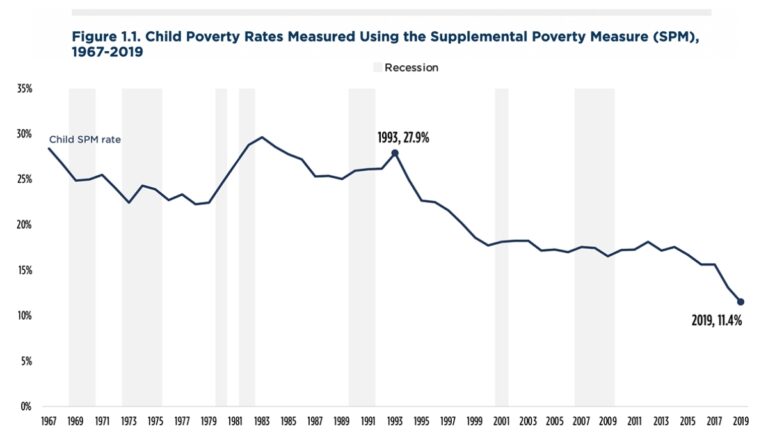Breaking Down Child Poverty
Over the last 29 years, child poverty has dropped by 60%. But more can be done to prioritize the children that may slip through the cracks.

Read Time: 2 minutes
Published:
Finally, some good news. Over the last 29 years, child poverty has dropped by 60%.
Researchers at Child Trends, an independent research organization, used the U.S. Census Bureau’s Supplemental Poverty Measure (SPM) to track child poverty from 1967 to 2019 and the economic, demographic, and policy changes that may have contributed to this accomplishment.
The graph shows a sharp drop in child poverty from 1993-1995 and a steadier downward trend until 2019, with only minor setbacks during the gray-shaded 2001 and 2008 economic recessions.
Government social safety net programs, such as income tax credits, Social Security, and SNAP, more than tripled their numbers of protected children from 1993-2019, and contributed importantly to protecting kids from poverty. Improved workforce opportunities, like higher employment rates and state minimum wages, explained another 33% of the overall trend.
Since 2019, child poverty fell further, from 11.4% to 5.2%, as emergency supports kept child poverty at bay during the height of COVID-19. The processes for applying to temporary assistance programs were simplified and more people qualified. But as these programs expire, the social safety net shrinks.
The researchers recommend recrafting social safety net programs to prioritize children who still fall through the cracks. Current policies set eligibility criteria based on parents’ characteristics, like employment and immigration status, rather than centering the child’s needs. This means children in immigrant families or whose parents are not stably employed are most often excluded from government supports.
While inflated prices for family necessities continue, children at risk of poverty may slip back over the line. States, such as Massachusetts and California, have prolonged some COVID assistance programs that helped keep families afloat. And other, lasting reforms would support children. Raising minimum wages and increasing access to affordable childcare help struggling parents. Measures that lower teen birth rates also reduce child poverty, including evidence-based prevention strategies and expanded abortion access. Where federal action is not politically possible, state governments can act.
Databyte via Dana Thomson, Renee Ryberg, Kristen Harper, James Fuller, Katharine Paschall, Jody Franklin, & Lina Guzman. Lessons From a Historic Decline in Child Poverty. Child Trends, 2022.



